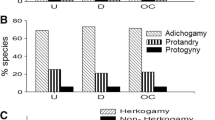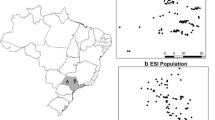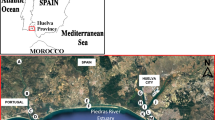Abstract
Successful sexual reproduction may be more important for regeneration of clonal species in high-latitude and -altitude areas than has been previously suggested. We investigated the potential of Vaccinium myrtillus, V. vitis-idaea and Empetrum nigrum ssp. hermaphroditum (E. hermaphroditum) for sexual reproduction at three sites in the forest–tundra ecotone in Finnish Lapland. We studied whether the potential differs between plant communities, whether disturbance enhances germination, and whether seedling emergence is limited by seed availability. We established a field experiment with disturbance and sowing treatments, and monitored seed and seedling numbers and survival rates for two years. The number of mature seeds of V. myrtillus was higher in plants from the tundra heath than in those from the coniferous and mountain birch forests. The number of mature seeds and seedlings emerging from the seed bank of E. hermaphroditum tended also to be higher in the tundra heath. Disturbance marginally increased the seedling emergence of V. myrtillus and E. hermaphroditum, whereas sowing generally increased the seedling numbers. The seedling number of V. myrtillus was lower in the tundra heath and that of E. hermaphroditum was lower in the coniferous forest than at the other sites. Seedling survival was equal for all plant species at all sites. We conclude that the capacity for sexual reproduction varies among plant communities, and seed availability is a stronger constraint than microsite availability for the studied species. Once the crucial early phase of seedling establishment is overcome, seedling survival enables successful recruitment of V. myrtillus, V. vitis-idaea and E. hermaphroditum in the subarctic area.

Similar content being viewed by others
References
Albert T, Raspé O, Jacquemart A-L (2003) Clonal structure in Vaccinium myrtillus L. revealed by RAPD and AFLP markers. Int J Plant Sci 164:649–655
Albert T, Raspé O, Jacquemart A-L (2008) Influence of clonal growth on selfing rate in Vaccinium myrtillus L. Plant Biol 10:643–649
Alsos IG, Spjelkavik S, Engelskøn T (2003) Seed bank size and composition of Betula nana, Vaccinium uliginosum, and Campanula rotundifolia habitats in Svalbard and northern Norway. Can J Bot 81:220–231
Auffret AG, Meineri E, Bruun HH, Ejrnæs R, Graae BJ (2010) Ontogenetic niche shifts in three Vaccinium species on a sub-alpine mountain side. Plant Ecol Divers 3:131–139
Baskin CC, Zackrisson O, Baskin JM (2002) Role of warm stratification in promoting germination of seeds of Empetrum hermaphroditum (Empetraceae), a circumboreal species with a stony endocarp. Am J Bot 89:486–493
Bienau M, Hatterman D, Kröncke M, Kretz L, Otte A, Esterhardt WL, Milbau A, Graae BJ, Durka W, Eckstein RL (2014) Snow cover consistently affects growth and reproduction of Empetrum hermaphroditum across latitudinal and local climate gradients. Alp Bot 124:115–129
Boudreau S, Ropars P, Harper KA (2010) Population dynamics of Empetrum hermaphroditum (Ericaceae) on a subarctic sand dune: evidence of rapid colonization through sexual reproduction. Am J Bot 95:770–781
Chambers JC (1993) Seed and vegetation dynamics in an alpine herb field: effects of disturbance type. Can J Bot 71:471–485
Chambers JC (1995) Disturbance, life history strategies, and seed fates in alpine herbfield communities. Am J Bot 82:421–433
Cooper EJ, Alons IG, Hagen D, Smith FM, Coulson SJ, Hodkinson ID (2004) Plant recruitment in the high arctic: seed bank and seedling emergence on Svalbard. J Veg Sci 15:115–224
de Witte LC, Armbruster GFJ, Gielly L, Taberlet P, Stöclin J (2012) ALFP markers reveal high clonal longevity in four key arctic-alpine species. Mol Ecol 21:1081–1097
Diemer M, Prock S (1993) Estimates of alpine seed bank size in two central European and one Scandinavian subarctic plant communities. Arct Alp Res 25:194–200
Donath TW, Eckstein RL (2008) Grass and oak litter exert different effects on seedling emergence of herbaceous perennials from grasslands and woodlands. J Ecol 96:272–280
Eckstein RL, Pereira E, Milbau A, Graae J (2011) Predicted changes in vegetation structure affect the susceptibility to invasion of bryophyte-dominated subarctic heath. Ann Bot 108:177–183
Eriksson O (2002) Ontogenetic niche shifts and their implications for recruitment in three clonal Vaccinium shrubs: vaccinium myrtillus, Vaccinium vitis-idaea, and Vaccinium oxycoccos. Can J Bot 80:635–641
Eriksson O, Ehrlén J (1992) Seed and microsite limitation of recruitment in plant populations. Oecologia 91:360–364
Eriksson O, Fröborg H (1996) “Windows of opportunity” for recruitment in long-lived clonal plants: experimental studies of seedling establishment in Vaccinium shrubs. Can J Bot 74:1369–1374
Eskelinen A, Virtanen R (2005) Local and regional processes in low-productive mountain plant communities: the roles of seed and microsite limitation in relation to grazing. Oikos 110:360–368
Forbis TA (2003) Seedling demography in an alpine ecosystem. Am J Bot 90:1197–1206
Foster BL, Dickson TI, Murphy CA, Karel IS, Smith VH (2004) Propagule pools mediate community assembly and diversity-ecosystem regulation along a grassland productivity gradient. J Ecol 92:435–449
Fournier DA, Skaug HJ, Ancheta J, Ianelli J, Magnusson A, Maunder M, Nielsen A, Sibert J (2012) AD model builder: using automatic differentiation for statistical inference of highly parameterized complex nonlinear models. Optim Method Softw 27:233–249
Gottfried M, Pauli H, Futschik A, Akhalkatsi M, Barancok P, Benito Alonso JL, Coldea G, Dick J, Erschbamer B, Fernandez Calzado MR, Kazakis G, Krajci J, Larsson P, Mallaun M, Michelsen O, Moiseev D, Moiseev P, Molau U, Merzouki A, Nagy L, Nakhutsrishvili G, Pedersen B, Pelino G, Puscas M, Rossi G, Stanisci A, Theurillat J-P, Tomaselli M, Villar L, Vittoz P, Vogiatzakis I, Grabherr G (2012) Continent-wide response of mountain vegetation to climate change. Nat Clim Change 2:111–115
Gough L (2006) Neighbor effects on germination, survival, and growth in two arctic plant communities. Ecography 29:44–56
Graae BJ, Alsos IG, Ejrnaes R (2008) The impact of temperature regimes on development, dormancy breaking and germination of dwarf shrub seeds from arctic, alpine and boreal sites. Plant Ecol 198:275–284
Graae BJ, Ejrnæs R, Lang SI, Meineri E, Ibarra PT, Bruun HH (2011) Strong microsite control of seedling recruitment in tundra. Oecologia 166:565–576
Granström A (1982) Seed banks in five boreal forest stands originating between 1810 and 1963. Can J Bot 60:1815–1821
Granström A (1987) Seed viability of fourteen species during five years of storage in a forest soil. J Ecol 75:321–331
Hautala H, Tolvanen A, Nuortila C (2001) Regeneration strategies of dominant boreal forest dwarf shrubs in response to selective removal of understorey layers. J Veg Sci 12:503–510
Hautala H, Tolvanen A, Nuortila C (2007) Recovery of pristine boreal forest floor community after selective removal of understorey, ground and humus layers. Plant Ecol 194:273–282
Hill NM, Vander Kloet SP (2005) Longevity of experimentally buried seed in Vaccinium: relationship to climate, reproductive factors and natural seed banks. J Ecol 93:1167–1176
Jeschke M, Kiehl K (2008) Effects of a dense moss layer on germination and establishment of vascular plants in newly created calcareous grasslands. Flora 203:557–566
Komulainen M, Vieno M, Yarmishko VT, Daletskaja TD, Maznaja EA (1994) Seedling establishment from seeds and seed banks in forests under long-term pollution stress: a potential for vegetation recovery. Can J Bot 72:143–149
Lindgren Å, Eriksson O, Moen J (2007) The impact of disturbance and seed availability on germination in the Scandinavian mountains. Arct Antarct Alpine Res 39:449–454
Loydi A, Eckstein RL, Otte A, Donath TW (2013) Effects of litter on seedling establishment in natural and semi-natural grassland: a meta-analysis. J Ecol 101:454–464
Manninen OH, Tolvanen A (2013) N-fertilization and disturbance impacts and their interaction in forest-tundra vegetation. Plant Ecol 214:1505–1516
Marcante S, Erschbamer B, Buchner O, Neuner G (2014) Heat tolerance of early developmental stages of glacier foreland species in the growth chamber and in the field. Plant Ecol 215:747–758
Mayer R, Erschbamer B (2011) Seedling recruitment and seed-/microsite limitation in traditionally grazed plant communities of alpine zone. Basic Appl Ecol 12:10–20
Milbau A, Shetsova A, Osler N, Mooshammer M, Graae BJ (2013) Plant community type and small-scale disturbances, but not altitude, influence the invasibility in subarctic ecosystems. New Phytol 197:1002–1011
Molau U, Larsson E-L (2000) Seed rain and seed bank along an alpine altitudinal gradient in Swedish Lapland. Can J Bot 78:728–747
Münzbergová Z, Herben T (2005) Seed, dispersal, microsite, habitat and recruitment limitation: identification of terms and concepts in studies of limitations. Oecologia 145:1–8
Nuortila C, Tuomi J, Laine K (2002) Inter-parent distance affects reproductive success in two-clonal dwarf-shrubs, Vaccinium myrtillus and Vaccinium vitis-idaea (Ericaceae). Can J Bot 80:875–884
Nuortila C, Tuomi J, Aspi J, Laine K (2006) Early-acting inbreeding depression in a clonal dwarf shrub, Vaccinium myrtillus, in a northern boreal forest. Ann Bot Fenn 43:36–48
Pauli H, Gottfried M, Dullinger S, Abdaladze O, Akhalkatsi M, Alonso JLB, Coldea G, Dick J, Erschbamer B, Calzado RF, Ghosn D, Holten JI, Kanka R, Kazakis G, Kollár J, Larsson P, Moiseev P, Moiseev D, Molau U, Mesa JM, Nagy L, Pelino G, Puşcaş M, Rossi G, Stanisci A, Syverhuset AO, Theurillat J-P, Tomaselli M, Unterluggauer P, Villar L, Vittoz P, Grabherr G (2012) Recent plant diversity changes on Europe’s mountain summits. Science 336:353–355
Persson HA, Gustavsson BA (2001) The extent of clonality and genetic diversity in lingonberry (Vaccinium vitis-idaea L.) revealed by RAPDs and leaf-shape analysis. Mol Ecol 10:1385–1397
R Core Team (2013) R: A language and environment for statistical computing. R Foundation for Statistical Computing, Vienna
Rodríguez A, Kouki J (2015) Emulating natural disturbance in forest management enhances pollination services for dominant Vaccinium shrubs in boreal pine-dominated forests. For Ecol Manag 350:1–12
Selås V (2000) Seed production of a masting dwarf shrub, Vaccinium myrtillus, in relation to previous reproduction and weather. Can J Bot 78:423–429
Soudzilovskaia NA, Graae BJ, Douma JC, Grau O, Milbau A, Shevtsova A, Wolters L, Cornelissen LHC (2011) How do bryophytes govern generative recruitment of vascular plants? New Phytol 190:1019–1031
Szmidt AE, Nilsson M-C, Briceño E, Zackrisson O, Wang X-R (2002) Establishment and genetic structure of Empetrum hermaphroditum populations in northern Sweden. J Veg Sci 13:627–634
Venäläinen A, Tuomenvirta H, Drebs A (2005) A Basic Finnish climate data set 1961–2000—descriptions and illustrations. Finnish Meteorol Inst Rep 5:1–27
Vieno M, Komulainen M, Neuvonen S (1993) Seed bank composition in a subarctic pine-birch forest in Finnish Lapland: natural variation and the effect of simulated acid rain. Can J Bot 71:379–384
Walck JL, Hidayati SN, Dixon KW, Thompson K, Poschlod P (2011) Climate change and plant regeneration from seed. Global Change Biol 17:2145–2161
Welch D, Scott D, Doyle S (2000) Studies on the paradox of seedling rarity on Vaccinium myrtillus L. in NE Scotland. Bot J Scotland 52:17–30
Welling P, Laine K (2000) Characteristics of the seedling flora in alpine vegetation, subarctic Finland, I. Seedling densities in 15 plant communities. Ann Bot Fenn 37:69–76
Welling P, Laine K (2002) Regeneration by seeds in alpine meadow and in heath vegetation in sub-arctic Finland. J Veg Sci 13:217–226
Welling P, Tolvanen A, Laine K (2004) The alpine soil seed bank in relation to field seedlings and standing vegetation in subarctic Finland. Arct Antarct Alpine Res 36:229–238
Acknowledgements
We thank Enontekiö jointly owned forest for the permission to conduct the field experiment in their forest and Metsähallitus for facilities and accommodation during the field work. Yrjö Norokorpi and Olli Autto contributed their experience in finding suitable sites in the Ounastunturi Fjell region. Carolin Nuortila gave us valuable comments during the writing process and helped us to recognize mature seeds from aborted seeds and unfertilized ovules. We also thank Laura Lampinen, Melissa Mayhew and Martin Sedlaczek for assisting in the field work. The study was financially supported by the Academy of Finland, SNS (Nordic Forest Research Co-operation Committee), Finnish Forest Research Institute and the NorNet Graduate School of Environmental Sciences.
Author information
Authors and Affiliations
Corresponding author
Additional information
Communicated by Philip Ladd.
Rights and permissions
About this article
Cite this article
Manninen, O.H., Tolvanen, A. Sexual reproduction of clonal dwarf shrubs in a forest–tundra ecotone. Plant Ecol 218, 635–645 (2017). https://doi.org/10.1007/s11258-017-0717-y
Received:
Accepted:
Published:
Issue Date:
DOI: https://doi.org/10.1007/s11258-017-0717-y




